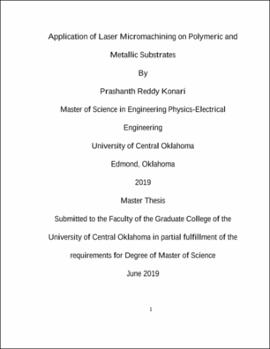| dc.description.abstract | LASER (Light Amplification by Stimulated Emission of Radiation) has many applications in engineering, biology, biomedical etc. Recent years, laser micromachining has become a promising technology for mass production of surface texturing on various polymeric substrates and metals. However, excessive roughness of channel surface, lack of control of process parameters and no uniformity of channel geometry are the ongoing challenges. The goal of the study is to determine the effect of laser system parameters on the surface of different kinds of polymers (PMMA, PDMS and Glass) as well as metals (Titanium). There are two specific objectives in this study. The first objective was to determine the effect of laser parameters on different kinds of polymers. A commercial MUSE laser system was used for machining three widely used microfluidic substrates to create microfluidic channels, which consists of a 45W laser tube with three degree of freedom (lateral, longitudinal and vertical). Four laser system parameters - speed, power, focal distance and number of passes are varied to fabricate straight microchannel on glass, PDMS and PMMA. The results show that higher speed produces lower depth while higher laser power produces deeper channel regardless of the substrate materials. The out-of-focus laser cut produces wider but shallower channel. However, for same speed and power, PDMS channel had the roughest surface and PMMA had smoother surface. In PMMA, a uniform and wider channel was produced with the number of passes, which when increased can control the bulging phenomenon. This comprehensive experimental investigation can provide guidance for the substrate material-based mass production of microchannels. The second objective was to investigate the effect of nitriding on a laser textured titanium surface to improve its optical properties for application in solar thermo photovoltaic. Nitriding of titanium alloy samples were carried out in plasma nitriding furnace after laser engraving. Full spectrum high power laser machine was used to make grooves on titanium alloy. The study found that laser textured nitride titanium has better surface properties and increased optical properties when compared to those of non-nitride titanium. For better understanding of the TiN on Ti , X-ray photoelectron spectroscopy (XPS) was carried out before and after plasma treatment. XPS analysis found nitriding has positive influence on the surface characteristics. Nitriding makes the laser grooved Ti surface more reflective compared to those of non-nitriding Ti surface. | en_US |
